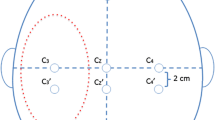Summary
Multi-modality evoked potentials and computed cranial tomography (CT) were performed in ten patients with Wilson's disease to determine if any of these studies would correlate reliably with neurologic status. While all four patients with CT abnormality had neurologic signs, two additional patients with neurologic findings had normal scans. Evoked responses were normal in nine patients. The remaining patient displayed abnormal visual, brainstem, and somatosensory evoked potentials, and follow-up studies after clinical deterioration revealed worsening of the brainstem and visual evoked potentials. This patient died unexpectedly from a subdural hematoma, and postmortem examination confirmed the radiographic findings of cortical atrophy of the cerebrum and cerebellum and bilateral cystic degeneration of the basal ganglia. However, localized demyelination in the visual, auditory, and sensory pathways was not present. We conclude that the clinical neurologic status of patients with Wilson's disease cannot be reliably predicted by either CT or multi-modality evoked potentials.
Similar content being viewed by others
References
Chiappa KH (1980) Pattern shift visual, brainstem auditory and short-latency somatosensory evoked potentials in multiple sclerosis. Neurology 30:110–123
Fujita M, Hosoki M, Miyazaki M (1981) Brainstem auditory evoked responses in spinocerebellar degeneration and Wilson disease. Ann Neurol 9:42–47
Harik SI, Post JD (1981) Computed tomography in Wilson disease. Neurology (NY) 31:107–110
Nelson RF, Guzman DA, Grahovac Z, Howse DCN (1979) Computerized cranial tomography in Wilson disease. Neurology (Minneap) 29:866–868
Ropper AH, Hatten HP, Davis KR (1979) Computed tomography in Wilson disease: report of two cases. Ann Neurol 5:102–103
Selekler K, Kansu T, Zileli T (1981) Computed tomography in Wilson's disease. Arch Neurol 38:727–728
Stockard JJ, Sharbrough FW (1980) Unique contributions of short-latency auditory and somatosensory evoked potentials to neurologic diagnosis. In: Desmedt JE (ed) Clinical uses of cerebral, brainstem and spinal somatosensory evoked potentials. Progress in Clinical Neurophysiology, vol 7. Karger, Basel, pp 231–263
Takano K, Kuroiwa Y, Shimada Y, Mannen T, Toyokura Y (1983) CT manifestation of cerebral white matter lesion in Wilson disease. Ann Neurol 13:108–109
Westmoreland BF, Goldstein NP, Klass DW (1974) Wilson's disease: electroencephalographic and evoked potential studies. Mayo Clin Proc 49:401–404
Williams JB, Walshe JM (1981) Wilson's disease — an analysis of the cranial computerized tomographic appearances found in sixty patients and the changes in response to treatment with chelating agents. Brain 104:735–752
Author information
Authors and Affiliations
Rights and permissions
About this article
Cite this article
Roach, E.S., Ford, C.S., Spudis, E.V. et al. Wilson's disease: evoked potentials and computed tomography. J Neurol 232, 20–23 (1985). https://doi.org/10.1007/BF00314035
Received:
Accepted:
Issue Date:
DOI: https://doi.org/10.1007/BF00314035




